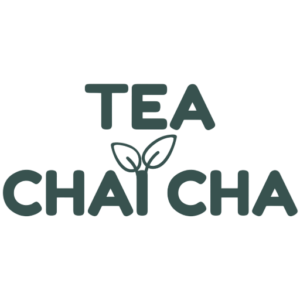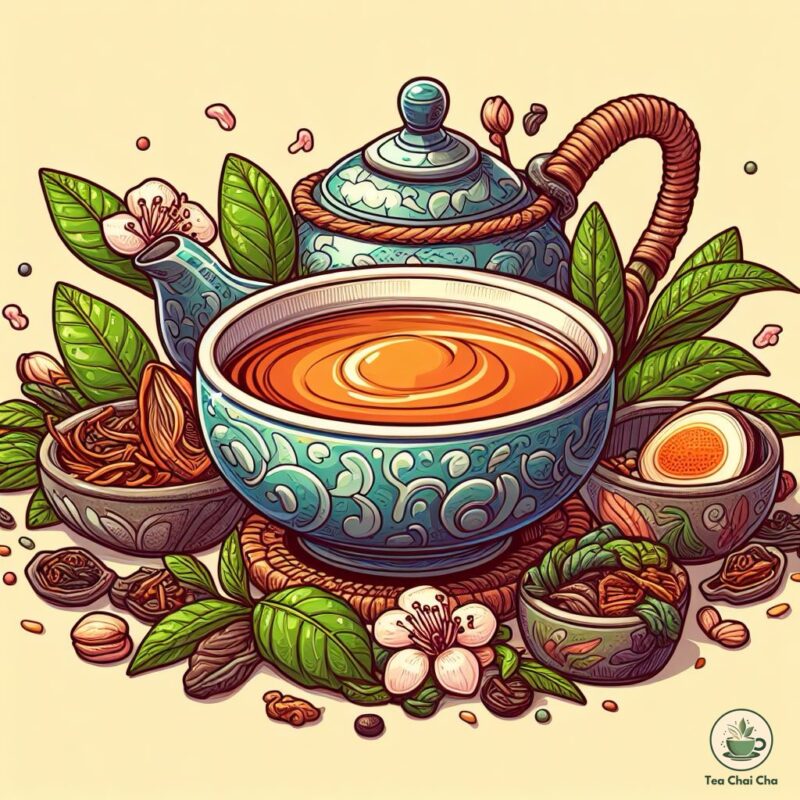Tie Guan Yin, also known as the Iron Goddess of Mercy, is a well-loved Chinese oolong tea.
You might also pronounce it as Ti Kuan or Ti Kwan.
It’s a bit unique because it’s not heavily oxidized like black tea, leaning more towards the green tea side.
You can find it in both roasted and unroasted varieties, each offering distinct flavors.
What they all have in common is a delightful fruity taste and a pleasant berry-like aroma.
Many tea enthusiasts appreciate its flavor and scent (yes, I do, too! Perhaps, not that much, reason ahead.)
Since you are here for the easy and quick recipe, lemme share how I brew this Chinese Iron Goddess tea.
Not only will you have an easy recipe at the end, but I will also share different brewing methods for this tea, some food pairings, and much more!
What Is Tieguanyin Tea?
Tieguanyin is one of the types of Oolong tea.
When it comes to tea, I’ve tried quite a few, and one that’s really famous worldwide is Ti Kwan Yin, or Ti Kuan Yin as some folks call it.
Personally, I can’t say it’s my absolute favorite, but I think I might have liked it more in the past.
See, back in the day, this tea used to be a bit darker, kind of like your typical oolong tea.
But things changed in the 1990s when a lighter version became all the rage.
This lighter Tieguanyin is only a bit more oxidized than green tea, and to be honest, it doesn’t quite hit the spot for me when it comes to oolong tea flavor.
But hey, a lot of people in the West get introduced to oolong through Tieguanyin.
It’s well-known and well-liked, even though it’s not my personal cup of tea.
It’s made from tightly rolled dry leaves that make a refreshing, bright, and floral brew.
Believe it or not, during the 1990s and 2000s, it was the most popular Chinese tea of them all.
Now, originally, the term “Iron Goddess Of Mercy” referred specifically to teas made from a certain type of tea plant.
But nowadays, it can also include teas made from different varieties, as long as they’re processed in the classic Tieguanyin style.
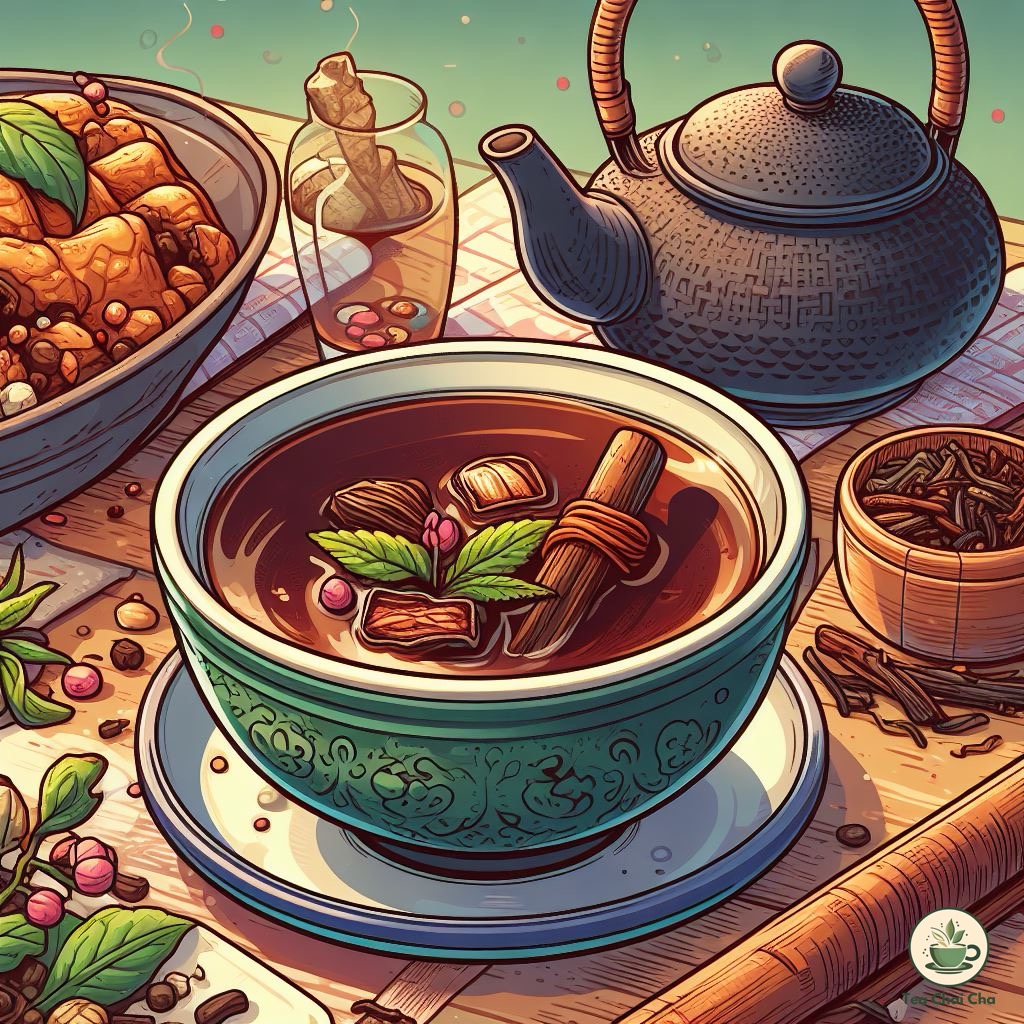
1. Location
Tieguanyin tea has a fascinating origin story.
This tea originally comes from the Anxi region of Fujian Province in China.
Anxi is a lovely place with two main growing areas: the inner mountains and the outer mountains.
The town where the tea first started is called Xiping, and it’s nestled in the outer mountains.
But if you’re looking for the most famous place where Tieguanyin is grown, that would be Hauizhi village, which is located in the inner mountains.
Interestingly, while Tieguanyin tea has its roots in Anxi, you’ll find it in neighboring regions like Zhang Zhou as well.
The climate and soil in these areas are just right for producing this special tea.
That’s why much of the Iron Goddess tea on the market today comes from these nearby regions.
2. Production
When it comes to producing Tieguanyin tea, it’s all about the leaves, not the buds.
Just like with other oolong teas, the more mature leaves are used, usually picked three to four at once along with the stems.
-> Harvesting All Year Round
Tieguanyin tea stands out because it’s harvested throughout all four seasons.
Usually, for most teas, spring is the most popular season for picking.
But with Tieguanyin, both spring and autumn harvests are quite sought after.
This sets it apart from other teas.
However, winter harvests are quite rare in the world of tea.
-> The Withering Process
After the leaves are picked, they are left to wilt in the sun until they become soft.
Subsequently, they are moved indoors for further wilting.
What makes Tieguanyin unique is a special step in the traditional process: shaking.
The leaves are shaken three to five times, a crucial part of making oolong tea.
However, it’s worth noting that the amount, strength, and timing of the shaking are determined by feel, making it challenging to replicate correctly.
-> Traditional vs. Modern Approach
Modern versions of Tieguanyin may differ from the traditional method.
The newer version involves less shaking or none at all.
The significant difference lies in the shaking and fermentation process.
Traditional Tieguanyin leaves ferment overnight after shaking, while modern variations undergo fermentation in a controlled environment.
Following fermentation, the leaves are fried in a wok to halt the oxidation process.
-> Rolling and Baking
While the leaves are still hot, they are tightly rolled into those distinctive ball shapes.
Subsequently, baking transforms them into “rough tea,” signifying that the primary processing is complete but additional refinement is required.
-> Refining the Tea
To refine Tieguanyin, extra processing involves roasting and stem removal, typically requiring two rounds of roasting to achieve perfection.
Removing stems and achieving the ideal roast are intricate and vital aspects of the tea-making process.
3. History
Back in the day, what could really make or break a tea in China was getting a thumbs-up from a top official.
And for Tieguanyin tea, it got a royal stamp of approval from none other than Emperor Qian Long, who lived a long time ago, from 1711 to 1799.
The story goes that Emperor Qian Long was seriously impressed with this tea.
He even said it had the “weight of iron and the appearance of the Avalokitasvara Bodhisattva.” That’s quite the compliment, right?
-> The Birth of It’s Name
Now, you might wonder, how did this tea get its fancy name, Tieguanyin? Well, it’s a cool story.
The Chinese word for iron is “tie,” and the Avalokitasvara Bodhisattva is often called “Guan Yin.”
So, they mashed those words together, and Tieguanyin was born.
It’s definitely a step up from what the locals used to call it: “dragonfly head and toad tail.” Quite an upgrade, I’d say!
-> The Gender Mystery
Here’s a little interesting tidbit:
The Avalokitasvara Bodhisattva is usually known as the Iron Goddess of Mercy in English.
But here’s the twist – the Avalokitasvara Bodhisattva is actually genderless.
When it took on a human form, it was a man, not a woman.
But in Chinese folk art, it’s often shown as female.
So, that’s where the English name comes from.
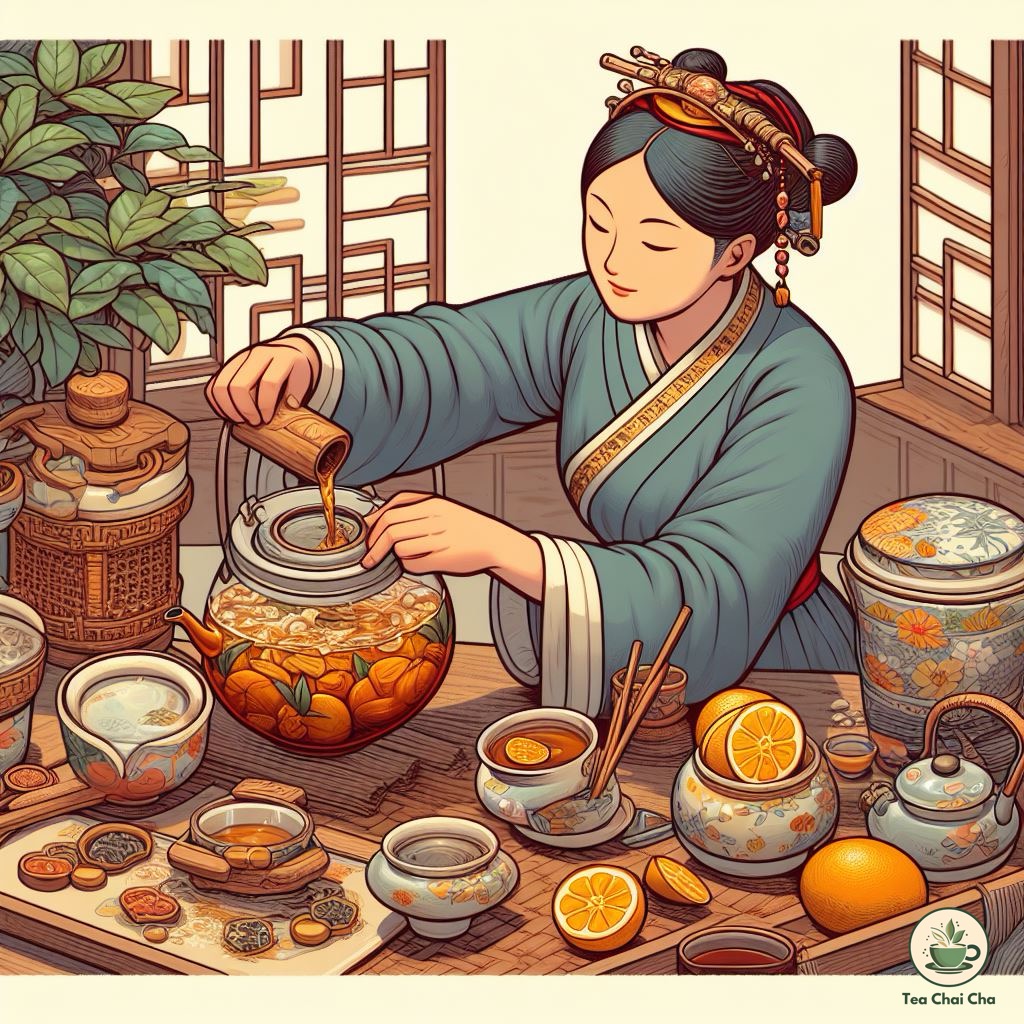
Tieguanyin Tea Preparation
Preparing Tieguanyin tea is a delightful experience that brings out the best flavors of this Chinese oolong tea.
To make a perfect cup, you’ll need a few essential ingredients and equipment.
Let me walk you through what you’ll need:
Ingredients
1. Tieguanyin Tea Leaves
You can find these leaves in various grades, but make sure to choose high-quality ones for the best taste.
2. Fresh Water
Opt for good quality H2O from your tap or a reliable water source.
The quality of water matters because it affects the taste of your tea, so make sure it’s clean and fresh.
Equipment
3. Teapot or Gaiwan
You’ll need a teapot or a gaiwan, which is a traditional Chinese lidded bowl used for brewing tea.
Both work well for brewing Tieguanyin tea; it’s a matter of personal preference.
4. Teacups
Get some teacups ready to serve your delicious tea.
Using small cups allows you to savor the flavor in smaller sips.
5. Tea Strainer
This is optional, but it can be handy if you want to catch any loose tea leaves that escape during brewing.
6. Tea Tray or Plate
Having a tea tray or a plate underneath your teapot or gaiwan is a good idea to catch any drips and keep your brewing area tidy.
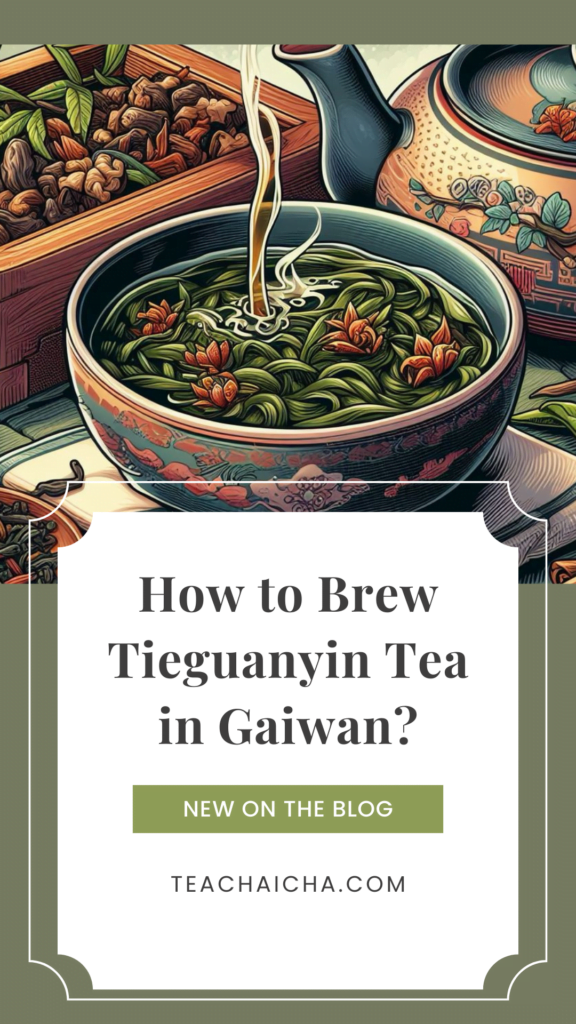
How to Brew Tie Guan Yin Tea in a Gaiwan
Brewing Tie Guan Yin tea in a traditional gaiwan is a wonderful way to experience the intricate flavors of this Chinese oolong tea.
Here’s a simple step-by-step guide to help you brew a perfect cup:
Step 1: Gather Your Ingredients and Equipment
For one serving of Tie Guan Yin tea, you’ll need:
- Tie Guan Yin Tea Leaves: About 5 grams (or approximately 1 tablespoon) of high-quality Tie Guan Yin tea leaves.
- Fresh Water: Approximately 150-200 ml (5-7 ounces) of clean, fresh water.
- Gaiwan: A gaiwan is a lidded bowl traditionally used for Chinese tea. It typically consists of three parts: the bowl, the lid, and a saucer.
- Teacup: Prepare a small teacup to pour your brewed tea into.
- Optional: Tea Strainer or Filter: If you prefer, you can use a tea strainer or filter to catch any loose tea leaves while pouring.
Step 2: Preheat the Gaiwan
Pour hot water into your gaiwan to preheat it.
Swirl the water around and then pour it out.
This step helps warm the gaiwan and cups, ensuring your tea stays at the right temperature during brewing.
Step 3: Add Tea Leaves
Place the Tie Guan Yin tea leaves into the preheated gaiwan.
Use about 5 grams of tea leaves for one serving.
Step 4: Rinse the Tea Leaves
Pour hot water (around 195-205°F or 90-96°C) over the tea leaves in the gaiwan.
Let it steep for just a few seconds (usually 5-10 seconds) and then pour this rinse water out.
This quick rinse helps to awaken the tea leaves and remove any impurities.
Step 5: First Infusion
Pour hot water over the tea leaves again, this time filling the gaiwan.
Place the lid on the gaiwan and let the tea steep for about 1-2 minutes for the first infusion.
Step 6: Pour and Enjoy
After the steeping time, carefully lift the lid of the gaiwan and hold it in place with your fingers to prevent the leaves from falling into your teacup.
Slowly pour the tea into your teacup.
Step 7: Re-infuse
Tie Guan Yin tea leaves are excellent for multiple infusions.
For subsequent (3-6) infusions, increase the steeping time slightly while maintaining the water temperature.
You can enjoy multiple cups of tea from the same leaves, each with its own unique flavor profile.
Scroll to the bottom to have complete recipe with ingredients and instructions.
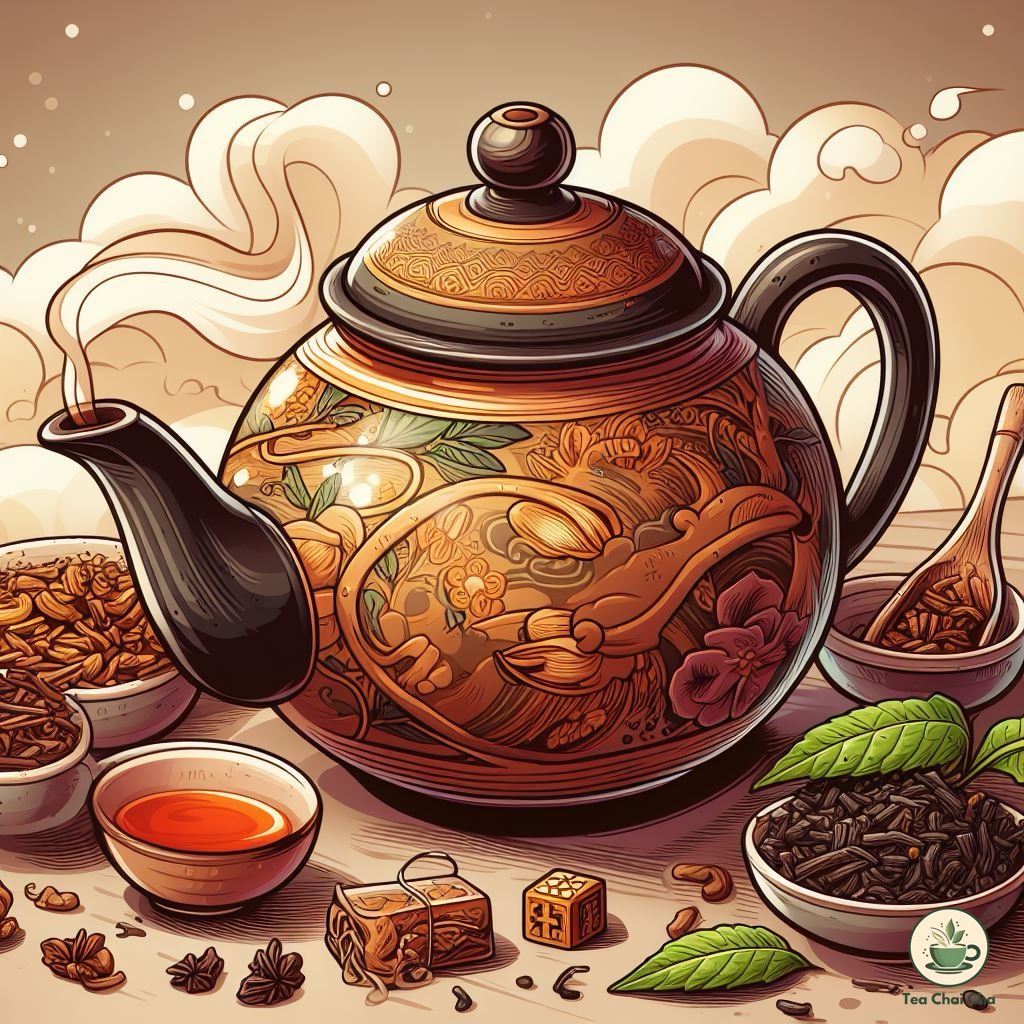
How to Brew Tie Guan Yin Tea in a Yixing Clay Teapot
Brewing Tie Guan Yin tea in a Yixing clay teapot is a wonderful way to bring out the full flavors of this Chinese oolong tea.
Here’s a simple step-by-step guide for brewing one serving:
Ingredients for One Serving
- 5-6 grams of Tie Guan Yin tea leaves
- Fresh, clean water
Tieguanyin Tea Preparation
1. Prepare Your Teapot: Begin by warming up your Yixing clay teapot
To do this, pour some hot water into the teapot, swirl it around, and then pour it out.
This helps to preheat the teapot and awaken its natural aroma-absorbing properties.
2. Measure the Tea Leaves: Use a scale or a teaspoon to measure out 5-6 grams of Tie Guan Yin tea leaves.
Place the measured leaves into your preheated teapot.
3. First Infusion: Pour hot water over the tea leaves. The water temperature should be around 195-205°F (90-96°C).
Let the tea steep for about 1-2 minutes for the first infusion.
Cover the teapot with the lid during steeping to maintain temperature.
4. Pour and Enjoy: After the steeping time, carefully pour the tea into your teacup.
Take in the wonderful aroma and admire the color of the tea.
Sip slowly and savor the unique flavor of Tie Guan Yin.
5. Multiple Infusions: For the second infusion, increase the steeping time to about 40-50 seconds.
For each subsequent infusion, add about 10-15 seconds to the steeping time.
6. Repeat as Desired: Continue brewing and sipping until the flavor diminishes to your liking.
You can usually get 3-6 infusions from the same tea leaves, each with its own unique character.
How to Brew Tie Guan Yin Tea in a Teapot or Travel Mug
If you don’t have a Yixing clay teapot, you can still enjoy Tie Guan Yin tea using a regular teapot or even a travel mug.
Here’s a simple guide for brewing one serving:
Ingredients for One Serving
- 5-6 grams of Tie Guan Yin tea leaves
- Fresh, clean water
Process
1. Prepare Your Teapot or Travel Mug: Make sure your teapot or travel mug is clean and ready for brewing.
2. Measure the Tea Leaves: Use a scale or a teaspoon to measure 5-6 grams of Tie Guan Yin tea leaves and place them in your teapot or travel mug.
3. Boil Water: Heat water to about 195-205°F (90-96°C) or just below boiling.
4. First Infusion: Pour the hot water over the tea leaves, covering them completely.
For a teapot, steep for 20 seconds to 3 minutes with the lid on. In a travel mug, place the lid on to keep the heat in.
5. Enjoy: After steeping, pour the tea into your cup or sip it directly from your travel mug. Take in the aroma and savor the initial infusion.
6. Subsequent Infusions: For the second infusion, increase the steeping time to 40-50 seconds.
Add about 10-15 seconds to the steeping time for each subsequent infusion.
7. Repeat: Continue brewing and sipping until the flavor suits your taste.
You can typically enjoy 3-6 infusions from the same tea leaves, even in a teapot or travel mug.
Tie Guan Yin Tea and Gongfu Style
Gongfu style is a traditional Chinese tea brewing method that is often used for Tieguanyin and other high-quality teas.
Here’s how it works:
1. Teapot
You’ll need a small teapot, often made of clay, called a Yixing teapot.
These teapots are known for absorbing the flavors of the tea over time, enhancing the taste with each use.
2. Tea Leaves
Use a higher tea-to-water ratio than usual.
Typically, you’d use about 1 gram of tea leaves for every 15-20 milliliters of water.
This means you’ll need a lot of tea leaves compared to a regular cup of tea.
3. Quick Infusions
Gongfu style involves very short steeping times, often starting with just a few seconds for the first infusion.
The goal is to bring out the tea’s flavors in a controlled manner without oversteeping.
4. Gongfu Set
To brew Tieguanyin in the Gongfu style, it’s common to have a complete set of tools, including a tea tray, tea cups, and a special pitcher to pour the tea from the teapot into the cups.
This set enhances the overall experience.
5. Multiple Infusions
You’ll steep the tea leaves multiple times, each time increasing the steeping duration slightly.
This allows you to enjoy several cups of tea from the same batch of leaves, with each infusion revealing different layers of flavor.
Here’s a general guideline:
-> First Infusion
The first infusion is typically very short, lasting only a few seconds (usually around 5-10 seconds).
This is a quick “rinse” to awaken the tea leaves and release their initial flavors and aromas.
-> Subsequent Infusions
As you continue, you can gradually increase the steeping time for each subsequent infusion.
For example, you might steep the second infusion for 20-30 seconds, the third for 40-50 seconds, and so on.
-> Taste Testing
After each infusion, taste the tea to see how it’s evolving.
You can stop when you feel the flavor has weakened or if it no longer suits your taste.
Some tea enthusiasts enjoy up to 10 or more infusions, while others may stop at 5 or 6.
Tieguanyin Tea Hot or Cold
In China, where Tieguanyin tea originates, it’s traditionally enjoyed as a hot tea.
Chinese tea culture places a lot of importance on the ritual of preparing and savoring tea.
So, the typical way to enjoy Tieguanyin is to steep the tea leaves in hot water.
You can use a gaiwan (a Chinese tea bowl with a lid) or a teapot for this.
The hot water brings out the full flavor and aroma of the tea leaves.
The Chinese often appreciate the layers of taste that come out when drinking Tieguanyin hot.
It starts with a floral and slightly fruity note, followed by a hint of sweetness and a soothing aftertaste.
It’s a truly delightful experience.
However, that doesn’t mean you can’t enjoy Tieguanyin cold!
Some people like to make iced Tieguanyin by brewing it hot and then cooling it down.
You can add ice cubes or let it chill in the fridge.
The cold version can be refreshing, especially on a hot day.
But it might have slightly different flavor notes compared to when it’s hot.

How to Make Tie Guan Yin Iced Tea
Making Tieguanyin iced tea is a refreshing way to enjoy this delightful beverage.
There are two primary methods: a quick iced tea method and a cold brew method.
I’ll explain both for you:
Ingredients for Hot-Brewed Tieguanyin Iced Tea
- 1 to 2 teaspoons of Tieguanyin tea leaves (per cup)
- Hot water
- Ice cubes
- Optional: sweetener (honey, sugar, or syrup)
- Optional: lemon or orange slices, mint leaves for garnish
Instructions for Hot-Brewed Tieguanyin Iced Tea
- Boil water and let it cool slightly (around 190-205°F or 88-96°C).
- Place the Tieguanyin tea leaves in a teapot or gaiwan.
- Pour the hot water over the tea leaves.
- Let it steep for about 3-5 minutes, depending on your taste preferences. The longer you steep, the stronger the flavor.
- After steeping, strain the tea into a heatproof container.
- Allow the hot tea to cool down to room temperature.
- Once it’s cooled, fill a glass with ice cubes.
- Pour the cooled Tieguanyin tea over the ice.
- If you like your iced tea sweet, you can add honey, sugar, or syrup to taste. Stir well to dissolve the sweetener.
- Garnish your iced tea with lemon or orange slices and a sprig of mint if you like.
- Enjoy your homemade Tieguanyin iced tea!
Ingredients for Cold-Brewed Tieguanyin Iced Tea
- 1 to 2 teaspoons of Tieguanyin tea leaves (per cup)
- Cold water
- Ice cubes
- Optional: sweetener (honey, sugar, or syrup)
- Optional: lemon or orange slices, mint leaves for garnish
Instructions for Cold-Brewed Tieguanyin Iced Tea
- In a glass or a pitcher, add the Tieguanyin tea leaves.
- Pour cold water over the tea leaves, using about 8 ounces (240 ml) of water per teaspoon of tea leaves.
- Cover the container and refrigerate it for at least 4-6 hours or overnight for a stronger infusion.
- After the steeping time, strain the cold-brewed tea into another glass or pitcher to remove the tea leaves.
- Fill a glass with ice cubes.
- Pour the cold-brewed Tieguanyin tea over the ice.
- Sweeten your iced tea if desired with honey, sugar, or syrup. Stir well.
- You can garnish with lemon or orange slices and a few mint leaves to add some extra flavor and freshness.
- Sip and enjoy your refreshing homemade Tieguanyin cold-brewed iced tea!
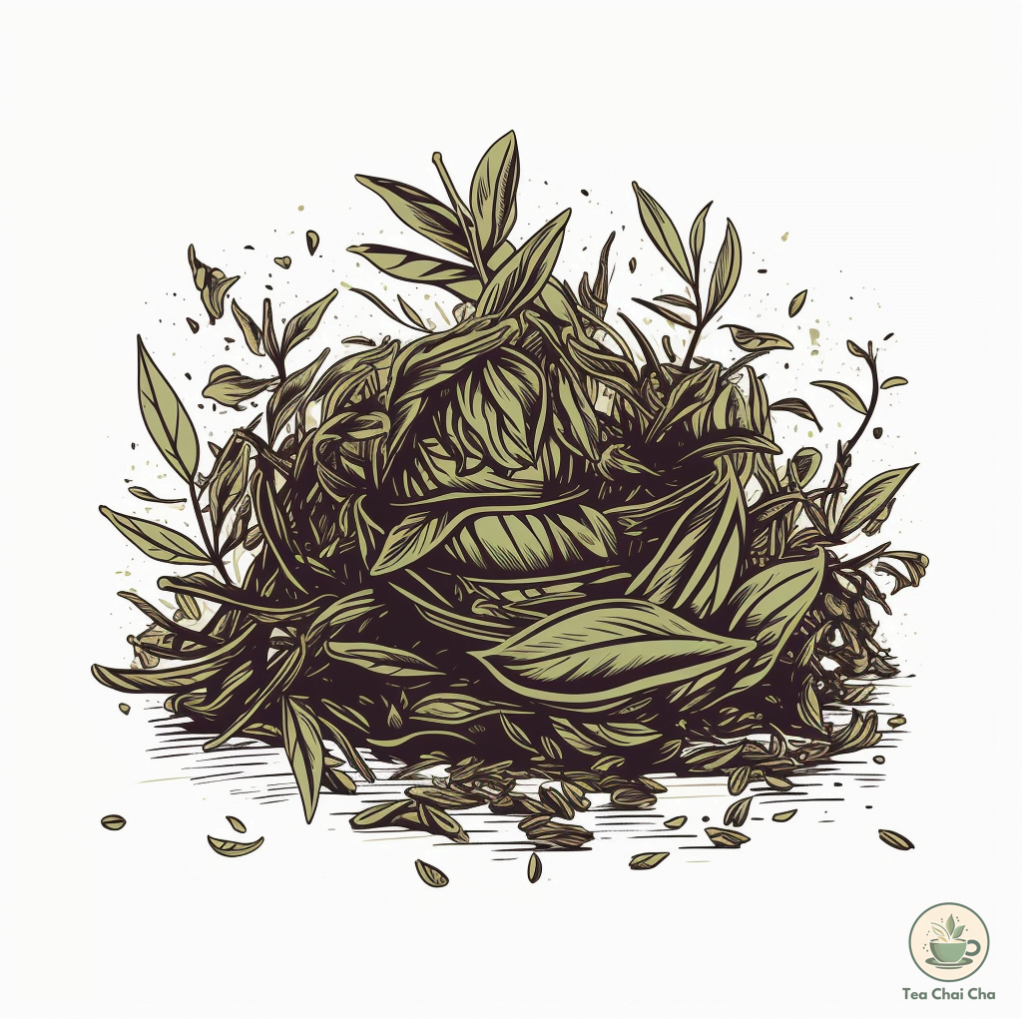
How to Make Tieguanyin Tea Taste Better
Making Tieguanyin tea taste even better is something I can share with you!
It’s all about enhancing its already wonderful flavor.
Here are some simple ways to do that:
1. Fresh and High-Quality Tea Leaves
First and foremost, starting with good-quality tea leaves is key.
Look for fresh, high-quality Tieguanyin tea leaves.
They should look green and vibrant, and that’s a great start to delicious tea.
2. Honey
I like to add a touch of honey to my cup of Tieguanyin.
It gives the tea a delightful sweetness that complements its floral and fruity flavors.
Just a teaspoon of honey can do wonders!
3. Fruits
You can also experiment with fruity flavors.
Add a slice of orange or a few berries to your cup of Tieguanyin tea.
The combination of the tea’s floral notes with the fruity freshness can be truly refreshing.
4. Lemon
A squeeze of lemon can brighten up your Tieguanyin tea.
The citrusy zing adds a refreshing twist to the tea’s flavor profile.
Just be careful not to add too much, as it can overpower the tea.
5. Clay Teapot
If you’re really into Tieguanyin, consider using a Yixing clay teapot.
These teapots are known for absorbing the tea’s aroma and flavors over time, making each cup more flavorful.

Tieguanyin Tea Food Pairing
Another (the best) way to enjoy your cup of Ti Kwan Yin oolong tea is by pairing it with the best tasting foods.
Hot Tieguanyin Tea Pairings
I love sipping on a hot cup of Tieguanyin tea, and here are some delicious food pairings I’ve discovered:
-> Dim Sum Delight
When I have a steaming pot of hot Tieguanyin tea, I find that dim sum dishes like dumplings, spring rolls, and bao buns make fantastic companions.
The tea’s floral and slightly sweet notes complement the savory fillings of these bite-sized treats perfectly.

-> Sushi Sensation
Sushi and Tieguanyin tea are a match made in heaven.
The tea’s gentle aroma and clean taste pair wonderfully with the fresh flavors of sushi.
-> Comforting Soups
On a chilly day, I often enjoy sipping hot Tieguanyin tea with soups, especially chicken noodle or miso soup.
The tea’s mild astringency cuts through the richness of the broth and adds a comforting layer of warmth.

-> Cheese and Crackers
Surprisingly, hot Tieguanyin tea pairs wonderfully with cheese and crackers.
The tea’s floral notes balance the creaminess of cheese, creating a delightful contrast.
-> Asian Noodles
Whether it’s a bowl of ramen, lo mein, or pad Thai, hot Tieguanyin tea complements Asian noodle dishes superbly.
Its earthy undertones accentuate the noodles’ savory and umami flavors.
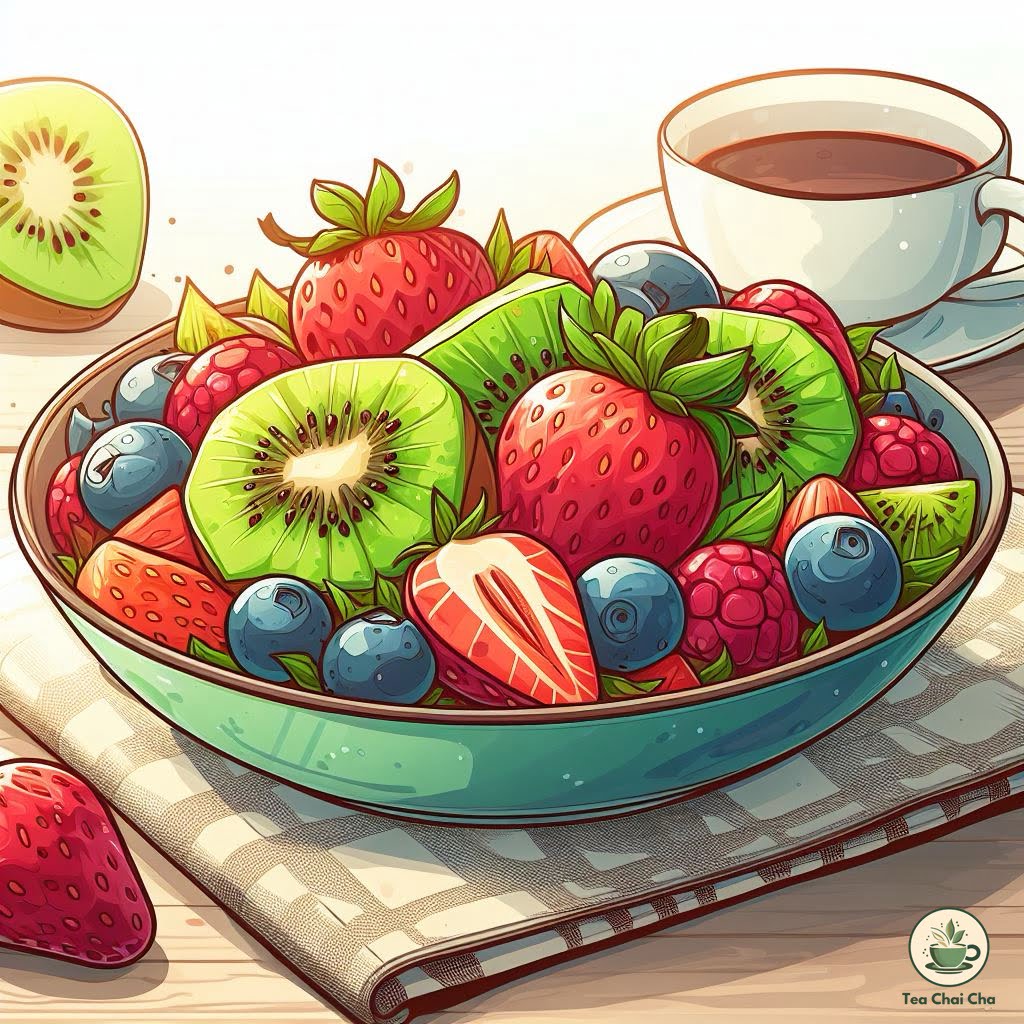
Cold Tieguanyin Tea Pairings
When I’m in the mood for a refreshing glass of cold Tieguanyin tea, these food pairings hit the spot:
-> Fruit Medley
Cold Tieguanyin tea is a perfect partner for a fruit salad or a platter of fresh berries.
Its crispness and natural sweetness complement the juiciness of fruits like strawberries, peaches, and melons.
-> Light Salads
When I want a light lunch, I often enjoy a cold Tieguanyin tea with salads, especially those with vinaigrette dressings.
The tea’s floral notes harmonize with the salad’s greens and tangy flavors.
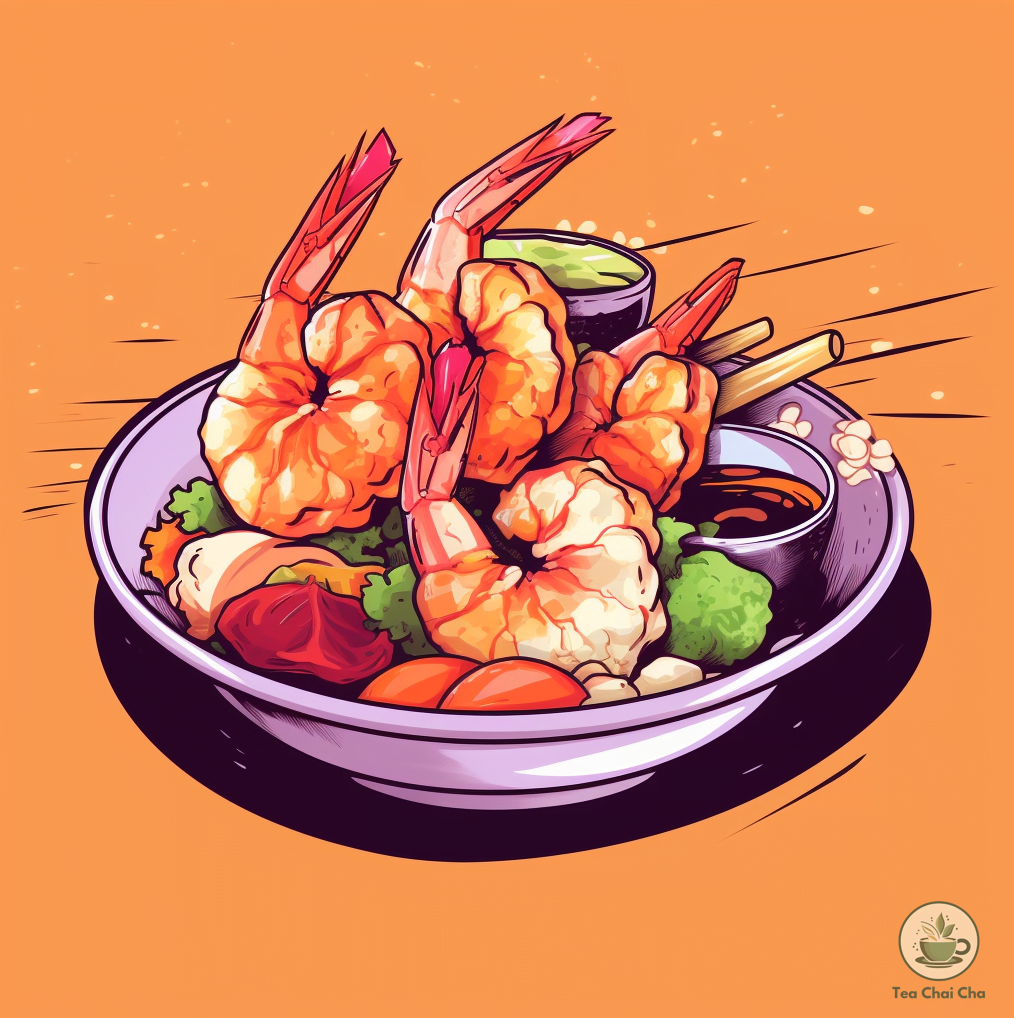
-> Seafood Delights
If you’re a seafood lover, you’ll appreciate the way cold Tieguanyin tea enhances the taste of dishes like shrimp cocktail, ceviche, or oysters.
Its clean and slightly vegetal profile complements the brininess of seafood.
-> Sushi Redux
Just like with hot tea, cold Tieguanyin tea remains an excellent choice to accompany sushi.
Its refreshing nature helps cleanse the palate between different sushi rolls.
-> Light Desserts
For dessert, I find that cold Tieguanyin tea pairs wonderfully with light options like lemon sorbet or a fruit tart.
Its subtle sweetness and floral notes enhance the sweetness of these treats without overpowering them.
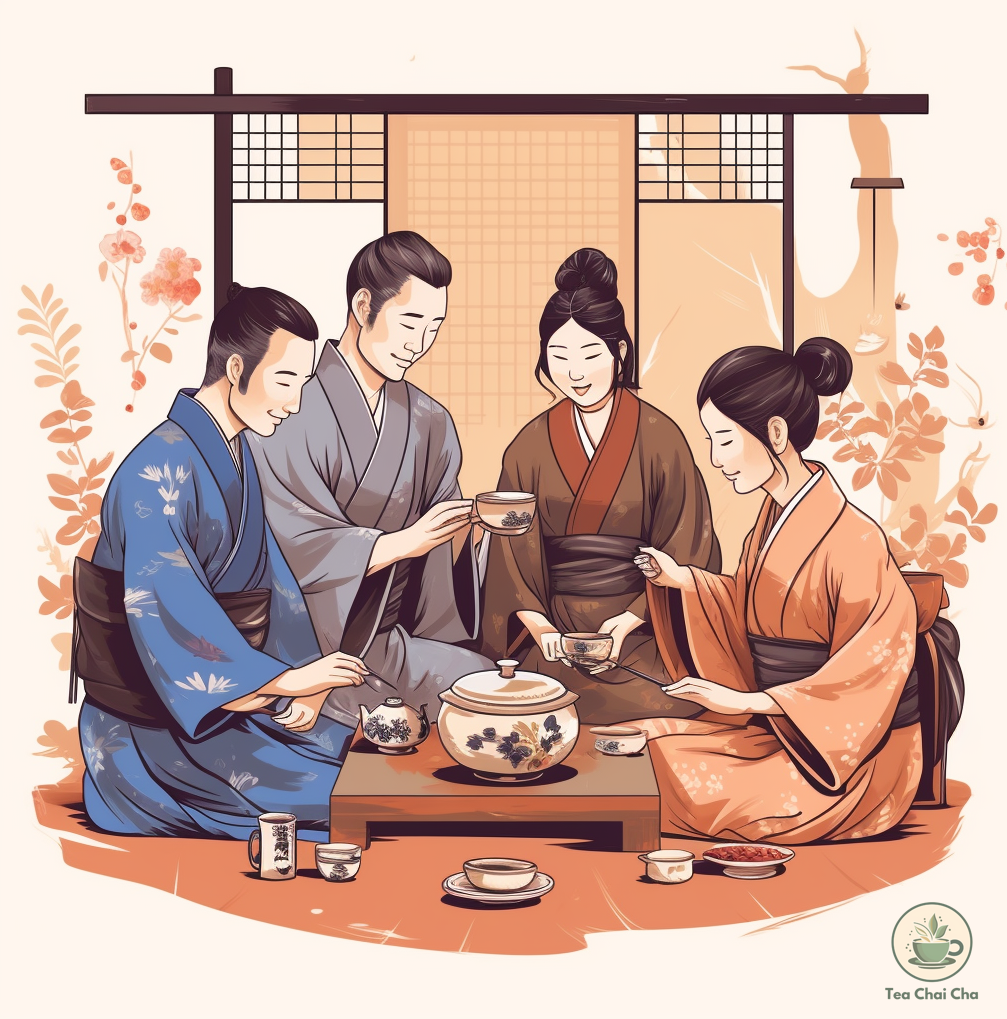
When to Drink Tieguanyin Oolong Tea
In my experience, the best time to drink Tieguanyin tea is during the afternoon.
It’s perfect for a little pick-me-up.
I find that it helps me stay alert and focused without the jitters of caffeine.
Plus, it’s a great way to take a break from my busy day and relax for a moment.
Another excellent time to savor this tea is after a meal.
Its unique flavor and aroma can aid in digestion, making it a delightful choice for a post-dinner treat.
I often find it soothing and comforting, like a gentle hug for my stomach.
While there’s no strict rule, these times have worked well for me.
Remember, the best time for you might be different, so feel free to experiment and see what fits your taste and schedule.
Hot Tieguanyin Tea for Special Occasions
As for enjoying hot Tieguanyin tea, I’ve found it’s perfect for certain occasions that call for warmth and relaxation:
-> Quiet Mornings
There’s something serene about starting your day with a hot cup of oolong tea.
Its gentle aroma and soothing taste help ease me into the day ahead.
-> Afternoon Tea Time
If you’re hosting a cozy afternoon tea gathering with friends or family, hot Tieguanyin tea is an excellent choice.
Pair it with a selection of pastries and finger sandwiches for a delightful tea party.
-> Crisp Autumn Evenings
As the weather cools down, you might find yourself reaching for a hot Tieguanyin tea on crisp autumn evenings.
Its warming qualities make it the ideal companion for enjoying a good book or having a quiet conversation by the fireplace.
-> Celebratory Moments
When celebrating special milestones or achievements, hot Tieguanyin tea adds an elegant touch.
Its floral notes and refined taste elevate the occasion, making it perfect for toasting to success.
Cold Tieguanyin Tea for Refreshing Moments
Cold Tieguanyin tea offers a different experience, making it suitable for various refreshing occasions:
-> Summer Picnics
On a sunny day, there’s nothing quite like a glass of cold Tieguanyin fruity tea to cool down.
It pairs wonderfully with picnic snacks like sandwiches, fruit, and salads, making outdoor gatherings even more enjoyable.
-> BBQ and Grilling
When you’re firing up the grill for a barbecue, cold Tieguanyin tea serves as a refreshing beverage to balance the smoky flavors of grilled meats and veggies.
-> Post-Exercise Hydration
After a workout or a long hike, I often reach for a bottle of cold Tieguanyin tea.
Its natural sweetness and hydrating qualities make it a healthier alternative to sugary sports drinks.
-> Poolside Relaxation
Lounging by the pool or at the beach?
Cold Tieguanyin tea in a thermos or a tumbler with ice is a perfect companion.
It keeps you cool and refreshed under the sun.
-> Al Fresco Dining
When dining outdoors at a café or a park, a cold glass of Tieguanyin tea is a sophisticated choice.
It pairs well with a variety of dishes, from sandwiches to seafood, elevating your outdoor
dining experience.
Related Recipes
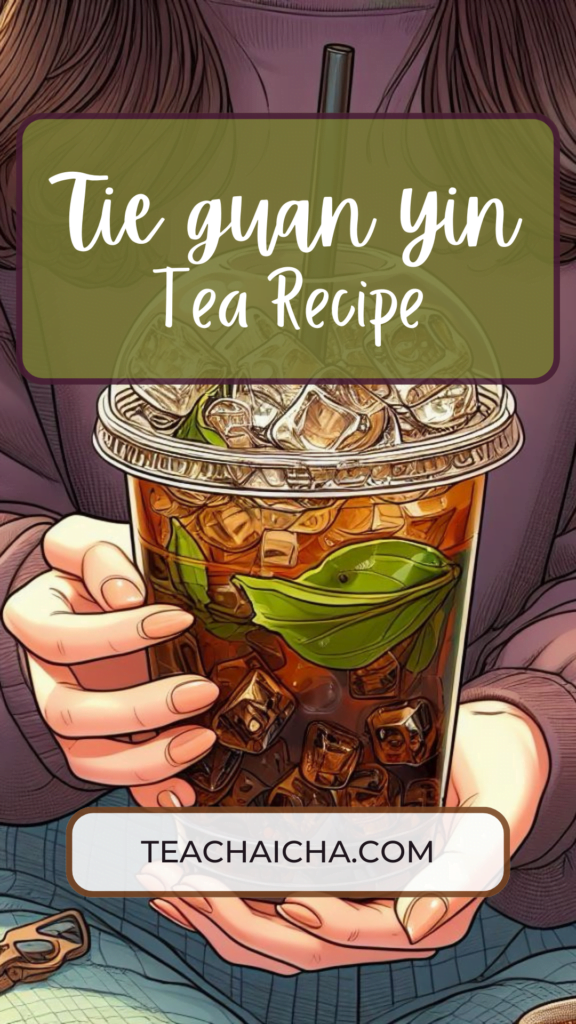
Classic Tieguanyin Tea (Iron Goddess) Recipe
Recipe by Tania FaysalCourse: DrinksCuisine: Chinese1
servings5
minutes2
minutes2
kcal7
minutesAn authentic Tieguanyin tea experience for one, in the comfort of your own home.
Ingredients
1 teaspoon (about 2-3 grams) of Tieguanyin tea leaves
8 ounces (about 240 ml) of hot (spring) water around 195-205°F (90-96°C)
Optional: A small teapot or infuser
Directions
- Preheat your teapot and cups: Begin by pouring hot water into your teapot and cups to preheat them. This will help maintain the optimal steeping temperature.
- Boil Water: Start by boiling fresh, clean water. Allow it to cool for a minute or two until it reaches the ideal temperature of 195-205°F (90-96°C).
- Measure Tea Leaves: Use a teaspoon to measure out about 2-3 grams of Tieguanyin tea leaves. You can adjust the amount to your taste, but this is a good starting point for one serving.
- Infuse the Tea: If you have a small teapot or infuser, place the tea leaves inside it.
Pour the hot water over the tea leaves. Ensure that they are fully submerged.
Let the tea steep for about 2-3 minutes. This time can vary depending on your taste preferences. Shorter steeping times result in a lighter flavor, while longer steeping times make the tea stronger. - Strain and Serve: If you used an infuser, simply remove it from the teapot or mug. Otherwise, strain the tea leaves as you pour the tea into your teacup.
- Enjoy: Take a moment to savor the delightful aroma and taste of your classic Tieguanyin tea.
Recipe Video
Notes
- Water Quality: Use fresh, filtered water for the best flavor. Avoid water with strong odors or flavors that could affect the tea.
- Teapot Choice: If you prefer a traditional touch, consider using a Chinese teapot for brewing Tieguanyin. It can enhance the overall experience.
- 3-6 Multiple Infusions: Tieguanyin tea is known for its ability to be steeped multiple times. Increase the steeping time slightly with each infusion to explore the evolving flavors.
- Adding Flavors: You can enhance the flavor of your Tieguanyin tea by adding a touch of honey or a slice of lemon if you prefer a sweeter or citrusy note. Experiment with other natural flavors like fresh mint leaves or a piece of ginger for a unique twist.
- Making Iced Tea: Brew Tieguanyin tea as usual and then let it cool to room temperature. Once cooled, you can refrigerate it. For a quicker iced tea, brew a stronger batch of Tieguanyin by using more tea leaves (5-6 grams) and slightly less water. Pour it over ice cubes and enjoy.
Frequently Asked Questions (FAQs)
What does Tieguanyin tea taste like?
Tieguanyin tea has a floral and slightly fruity flavor with hints of orchid, lilac, and a subtle sweetness.
Some people also notice a creamy or buttery undertone to its taste. Overall, it’s a very aromatic and refreshing tea.
Does Tieguanyin tea have caffeine?
Yes, Tieguanyin tea does contain 12-14 mg caffeine per 100 ml, but the caffeine content can vary depending on how it’s prepared.
On average, it contains moderate levels of caffeine, similar to other oolong teas.
Is Tieguanyin a real tea?
Yes, Tieguanyin is indeed a real tea. It’s a type of oolong tea that originates from China, particularly the Fujian province.
Tieguanyin is highly regarded for its unique flavor and aroma and has a long history of cultivation and enjoyment by tea enthusiasts worldwide.
How many calories are in Tieguanyin tea?
Tieguanyin tea is very low in calories.
A typical cup of brewed Tieguanyin tea, without any added sweeteners or milk, contains only a few calories, typically less than 5 calories per cup.
